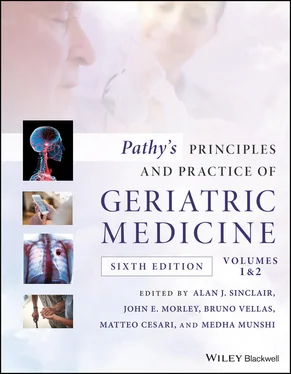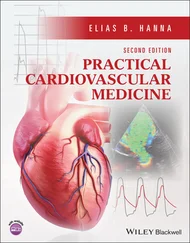Pathy's Principles and Practice of Geriatric Medicine
Здесь есть возможность читать онлайн «Pathy's Principles and Practice of Geriatric Medicine» — ознакомительный отрывок электронной книги совершенно бесплатно, а после прочтения отрывка купить полную версию. В некоторых случаях можно слушать аудио, скачать через торрент в формате fb2 и присутствует краткое содержание. Жанр: unrecognised, на английском языке. Описание произведения, (предисловие) а так же отзывы посетителей доступны на портале библиотеки ЛибКат.
- Название:Pathy's Principles and Practice of Geriatric Medicine
- Автор:
- Жанр:
- Год:неизвестен
- ISBN:нет данных
- Рейтинг книги:3 / 5. Голосов: 1
-
Избранное:Добавить в избранное
- Отзывы:
-
Ваша оценка:
- 60
- 1
- 2
- 3
- 4
- 5
Pathy's Principles and Practice of Geriatric Medicine: краткое содержание, описание и аннотация
Предлагаем к чтению аннотацию, описание, краткое содержание или предисловие (зависит от того, что написал сам автор книги «Pathy's Principles and Practice of Geriatric Medicine»). Если вы не нашли необходимую информацию о книге — напишите в комментариях, мы постараемся отыскать её.
Pathy’s Principles and Practice of Geriatric Medicine
Pathy's Principles and Practice of Geriatric Medicine — читать онлайн ознакомительный отрывок
Ниже представлен текст книги, разбитый по страницам. Система сохранения места последней прочитанной страницы, позволяет с удобством читать онлайн бесплатно книгу «Pathy's Principles and Practice of Geriatric Medicine», без необходимости каждый раз заново искать на чём Вы остановились. Поставьте закладку, и сможете в любой момент перейти на страницу, на которой закончили чтение.
Интервал:
Закладка:
In cases of accelerated iron loss (i.e. acute or chronic bleeding), invasive diagnostic tests such as ultrasounds, esophagogastroduodenoscopy (EGD), or colonoscopy may be indicated, although no clear guidelines exist on which procedure should be performed first. 26In premenopausal women, menstruation is a common cause for IDA. In both older men and postmenopausal women, gastrointestinal bleeding sources (i.e. gastritis, bleeding ulcers, arteriovenous malformations) are common and must be further investigated. Specifically, gastrointestinal malignancies (i.e. colon or gastric cancer) are of concern and occur in up to 10% of those older than 65 with new diagnosis of IDA. 27IDA can also be seen in up to 25–50% of those who have had bariatric weight‐loss surgery because bowel resection, especially of the duodenum, interferes with iron absorption. 28
In summary, IDA is caused from inadequate iron intake, decreased iron absorption, increased iron demand, or accelerated iron loss. It is typically diagnosed by laboratory studies that show a low haemoglobin, low serum iron, high TIBC, low transferrin saturation, and reduced ferritin levels. A ferritin level of less than 30 ng/mL is diagnostic of IDA, whereas a ferritin level greater than 100 ng/mL generally excludes the diagnosis of IDA. Iron deficiency is treated with IV or PO iron supplementation depending on severity of anaemia, absorption profile, cost, and tolerability of side effects. Oral supplementation should be given only once daily due to receptor saturation and lack of absorption with more frequent dosing. For those who do not respond to supplementation, further investigation must be undertaken to rule out chronic bleeding sources.
Vitamin B12 deficiency anaemia
Vitamin B12 deficiency anaemia is much less common than IDA in older adults but can be associated with significant morbidity and should be evaluated. The prevalence of vitamin B12 deficiency (also known as cobalamin deficiency) increases with age and ranges between 5–40% depending on the cut‐off level used. 29‐31One Canadian study of 412 nursing home residents found the overall prevalence to be 13.8% on nursing home admission and a new yearly incidence rate of 4% one‐year post‐admission. 32
Vitamin B12 deficiency anaemia can result from either inadequate intake or impaired absorption. Similar to iron deficiency, inadequate intake can occur in those who follow specialized or vegetarian diets. Unlike iron, however, vitamin B12 is strictly found in animal products, including red meat, eggs, and dairy, making vegetarians or vegans particularly susceptible to deficiencies. Medications that decrease the acidity of the stomach, such as proton pump inhibitors and histamine‐2 blockers, can impair B12 absorption. Metformin, a commonly used medication for treatment of diabetes mellitus, is also associated with B12 deficiency, and long‐term users should be screened for deficiency. 33Other causes of impaired absorption include a history of intestinal or gastric resection, intestinal bacterial overgrowth, inflammatory bowel disease, and atrophic gastritis.
Vitamin B12 is a water‐soluble vitamin and plays an important role in cellular metabolism. It is required for DNA synthesis, mitochondrial function, and red blood cell production. 34It also converts folate to its biologically active form and, when deficient, can cause a folate deficiency. In the stomach, vitamin B12 is cleaved from animal proteins by stomach acid and then bound to R‐protein. The R‐protein/B12 complex travels to the duodenum, where it is cleaved by pancreatic enzymes; the resultant B12 molecule is then bound to intrinsic factor, which is secreted by gastric parietal cells. The B12/intrinsic factor complex continues to the terminal ileum, where it is absorbed into the blood circulation. In the blood, B12 is bound to a transport protein called transcobalamin and carried into cells to be used for essential reactions in cellular metabolism. In certain cases where gastric pH is high (often medication‐induced or caused by achlorhydria), B12 is not separated from animal proteins, and thus adequate absorption does not occur. Atrophic gastritis, caused by the autoimmune destruction of gastric parietal cells, often leads to inadequate intrinsic factor production and thus vitamin B12 malabsorption with resultant anaemia. One study estimated that 20–50% of vitamin B12 deficiency cases in adults are due to atrophic gastritis. 35It is important to note that a small percentage (1–5%) of ingested vitamin B12 is passively absorbed in the ileum without being bound to intrinsic factor. If not needed for cellular metabolism, vitamin B12 is stored in the liver. Vitamin B12 stores deplete very slowly, and it may take as long at 5–10 years for symptoms to manifest once a deficiency in intake or malabsorption occurs. 34
Along with folate deficiency and alcoholism, vitamin B12 deficiency is one of the three most common causes of macrocytosis (defined as blood cells with MCV levels >100 fL) in older adults. 36However, up to 17% of patients do not present with the classic finding of macrocytosis, and up to 28% of B12‐deficient patients have a normal haemoglobin, making the diagnosis challenging at times. 37There is no gold standard diagnostic test for vitamin B12 deficiency. In general, vitamin B12 deficiency anaemia is diagnosed by a low haemoglobin and low vitamin B12 levels on laboratory studies ( Figure 22.4). No absolute cut‐off levels defining B12 deficiency exist, and some controversy surrounds what specific level warrants treatment. The WHO suggests that vitamin B12 levels of less than 200 pg/mL be considered deficient, but many research studies use the level of 150 pg/mL to define deficiency. Around these levels, homocysteine and methylmalonic acid (MMA) become elevated and can aide in the diagnostic process, particularly when B12 levels are equivocal (i.e. 200–350 pg/mL). 38In fact, B12 levels of less than 200 pg/mL are associated with the presence of elevated MMA and homocysteine levels with a diagnostic sensitivity of greater than 96%. 37Because MMA is as sensitive as – but more specific than – homocysteine, it is the confirmatory test of choice. 37It should be noted that MMA and homocysteine levels are expensive diagnostic tests and have the best utility when the diagnosis of vitamin B12 deficiency is unclear (i.e. symptomatic patients with low‐normal B12 levels or asymptomatic patients with a high risk of B12 deficiency and low‐normal B12 values). No consensus exists on when additional diagnostic tests should be added.
Vitamin B12 deficiency may lead to non‐specific symptoms such as peripheral neuropathy, gait ataxia, mood changes, weakness, cognitive impairment, vitiligo, and glossitis 39; however, symptoms are typically absent. To date, no major medical organization has published guidelines on routine screening for B12 deficiency at the population‐based level. Clinicians should have a high suspicion in at‐risk individuals (i.e. those with history of bowel resection, atrophic gastritis, inflammatory bowel disease, or specialized diets and metformin or acid‐suppressant users) and consider screening on an annual basis. It should be noted that falsely normal B12 levels can occur in those with hepatic or renal disease or myeloproliferative disorders. Falsely low B12 values may be seen in those with folate deficiency or multiple myeloma. 40
Fortunately, vitamin B12 deficiency anaemia is readily treatable. The goals of treatment are to alleviate any symptoms, if present, and replenish the vitamin B12 stores in the liver. Treatment options include intramuscular (IM) B12 or oral B12. The typical IM dose is 1000 mcg weekly for severe deficiency and then monthly for maintenance treatment. About 10–15% of each injection is absorbed, so stores are replenished quickly. However, in most cases, oral supplemental B12 is as effective as IM supplementation and is less costly. Oral B12 can be absorbed even in the presence of inadequate acid secretion because it does not have to be broken apart from animal protein to be bound to intrinsic factor. 41Higher oral doses (2000 mcg daily) can be used indefinitely to treat B12 deficiency from pernicious anaemia/atrophic gastritis because of the small amount of passive free absorption of B12 not bound to intrinsic factor that occurs. 42No evidence‐based guidelines dictate specific dose efficacy or treatment duration. In general, haemoglobin and vitamin B12 levels should be checked again around three months after treatment initiation to ensure treatment success. In those with pernicious anaemia or history of gastric or bowel resection, the treatment will be needed indefinitely because absorption with these conditions will likely remain deficient.
Читать дальшеИнтервал:
Закладка:
Похожие книги на «Pathy's Principles and Practice of Geriatric Medicine»
Представляем Вашему вниманию похожие книги на «Pathy's Principles and Practice of Geriatric Medicine» списком для выбора. Мы отобрали схожую по названию и смыслу литературу в надежде предоставить читателям больше вариантов отыскать новые, интересные, ещё непрочитанные произведения.
Обсуждение, отзывы о книге «Pathy's Principles and Practice of Geriatric Medicine» и просто собственные мнения читателей. Оставьте ваши комментарии, напишите, что Вы думаете о произведении, его смысле или главных героях. Укажите что конкретно понравилось, а что нет, и почему Вы так считаете.












